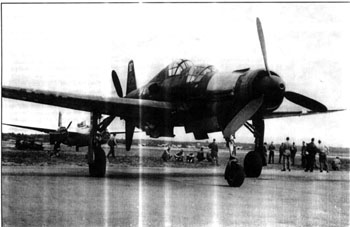
Dornier 335 Arrow
HOW TO DRAW A CROWD 1945: ETO STYLE
By Merle Olmsted
Start with a US airbase in recently defeated Germany, add one strange, exotic airplane, and stir well. The crowd, from hangars, shops, offices, clubs, and ramps, will appear like magic.
At least they did when a Dornier 335 “Arrow” made its debut arrival at Neubiberg Air Base in the summer of 1945. In the first photo, the crowd is relatively small, even though the aircraft had made a low, highspeed pass across the base, the very noisy engines getting many people’s attention.
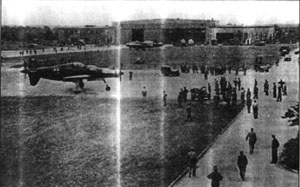
In Photo Two, taken two or three minutes later, the forward engine is still running and the crowd has increased dramatically. This writer is somewhere in the group (recognizable by his mechanic’s overalls), and about to begin taking his own photos of the very odd machine. The two arrival photos were taken by Tech. Sgt. Arthur Schalick, who was on duty in the control tower at the time. Photo Three shows the German pilot leaving the aircraft; he is the figure in white coveralls at the trailing edge of the wing. The identity of the other man who apparently had flown in with him is unknown. Photo Four was taken an hour or so later by this writer. An A-20 with 357th Fighter Group red and yellow checked cowls has arrived and parked behind it. Most of the crowd has dispersed, except for a few diehards seated on the grass.
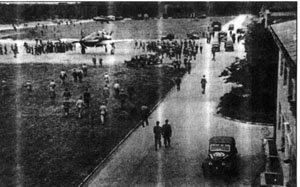
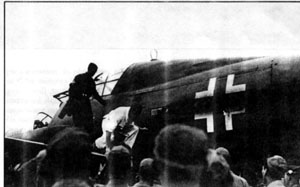
Neubiberg Air Base, Station R-85, just outside Munich, had been occupied since about July by the 357th Group, late of the Mighty Eighth Air Force. It had come here to die, and did so a year or so later when it lost its identity in a series of redesignations.
The 335 had been found, probably at the Dornier factory at Oberpfaffenhofen, and was flown to R-85 for temporary safe keeping. It still bore German markings, but US insignia was applied before its departure. A single-seat Do-335, which arrived later, was in bare metal finish with US markings.
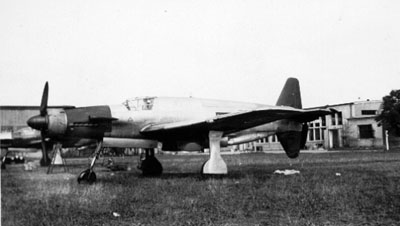
We did not know it at the time but postwar publications tell us that about 30 “Arrows” were built, the first flying in the fall of 1943. Apparently only about five were two-seaters, the one here being the second production aircraft, No. 112, seen on the upper fin. William Green (“The Warplanes of the Third Reich”) illustrates this type with the author’s photo, as seen here.
The airplane was flown several times, and the story goes that it was flown once by Capt. Robert D. Brown in a dogfight with 357th ace Major Don Bochkay. The big Dornier was very fast, but not as agile as the P-51.
The identity of the German pilot is unknown but another 357th pilot, Lt. Mike Becraft, got to know him quite well and remembers his name as Hofmann (Hoffmann?). There was a Ludwig “Willi” Hofmann involved in ferrying Me-262s to a French port earlier in the summer of 1945, and this may well be the same man. Becraft traded pilot’s wings with him and still has the Luftwaffe badge. Dornier 335A-12, No. 112, was transferred to the RAF, departing Neubiberg on 7 September 1945 with a Squadron Leader. McCarthy ferrying the aircraft to Britain. It met its end on 18 January 1946 when a fire developed in the rear engine, which destroyed the elevator controls. Group Captain Alan Hards was killed in the ensuing crash.
This article first appeared in the Journal of the American
Aviation Historical Society, Summer 1997.

